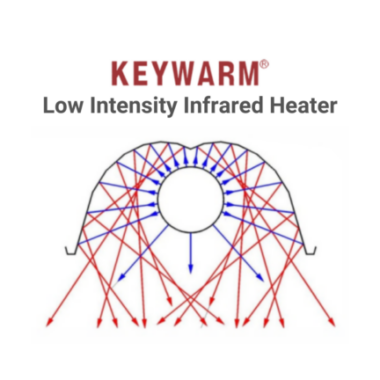The role of efficient heating in agricultural settings cannot be overstated, especially when it comes to poultry and livestock care. Maintaining the optimal living conditions for animals not only promotes better health but also boosts productivity and economic outcomes for farmers. Heating systems like infrared heaters, gas infrared heaters, and indirect air heaters are revolutionizing agricultural heating by providing targeted and efficient warmth where it’s needed most. Below, we explore why infrared technology is ideal for poultry and livestock care, the features of gas infrared heaters, the benefits of low stratification heating, and how to select the perfect poultry heater or livestock heater for your needs.
Table of contents:
Why Infrared Technology Works Best for Poultry and Livestock Care
Gas Infrared Heaters That Maximize Comfort for Animals
Benefits of Low Stratification Heating in Agricultural Settings

Why Infrared Technology Works Best for Poultry and Livestock Care
Infrared technology is a game changer in agricultural heating, providing radiant heat directly to animals and surrounding surfaces without wasting energy on heating the air. This method mimics the sun’s natural warmth, offering a comfortable and stable environment for livestock and poultry, even in drafty barns or open sheds. Infrared radiant heaters work by emitting heat waves that penetrate the body’s surface, keeping animals warm in a more natural and efficient way while improving blood circulation and comfort. This heating approach has proven exceptionally beneficial in preventing respiratory problems in poultry and livestock, as it reduces moisture and dampness in the air. The directional nature of infrared heat ensures efficient coverage without unnecessary heat loss, making it an eco-friendly and cost-effective solution.
Gas Infrared Heaters That Maximize Comfort for Animals
Gas infrared heaters are among the most efficient tools for heating agricultural setups. They operate by mixing air and gas to create controlled combustion, generating radiant heat that warms livestock or poultry directly. Tools like low-intensity vacuum infrared heaters are particularly effective in large spaces like barns or warehouses with high ceilings. These heaters offer precise, localized heating and are perfect for providing instant warmth during the cold months. Gas infrared heaters, such as the ones offered by KeyWarm, use materials like high-polished aluminum reflectors to maximize radiant efficiency, delivering consistent warmth and reducing energy costs by up to 30% compared to traditional air-based heating systems. They are durable, easy to maintain, and adaptable for use with natural gas or propane, making them a versatile choice for farmers. By eliminating the need for traditional heat-distribution systems, gas infrared heaters ensure minimal energy losses, which is ideal for sprawling agricultural installations.
Benefits of Low Stratification Heating in Agricultural Settings
Low stratification heating systems are fundamentally designed to address one of the biggest challenges of heating in agribusiness—heat distribution in large spaces. Stratification is the process by which warm air rises and accumulates at the ceiling while colder air sinks to the ground. This is particularly problematic in barns, poultry farms, and livestock sheds, as animals are left in the colder, lower layers of air. Infrared heaters mitigate this issue by providing direct heat to the ground level, where it is needed the most. Low-intensity vacuum infrared heaters, for example, reduce stratification by emitting radiant heat that avoids the upward movement of warm air. This makes the heating system highly efficient, as it prevents energy wastage and ensures a uniform distribution of warmth across the space. By lowering fuel consumption and improving thermal comfort, low stratification heating systems can reduce greenhouse gas emissions and make poultry and livestock care more sustainable.
Choosing the Right Infrared Heater for Poultry Farms
Selecting the appropriate heater for your farm requires assessing specific operational needs. For poultry farms and livestock setups, choosing between options like a gas infrared heater, an indirect air heater, or a low-intensity vacuum infrared heater depends on the size of your space, ventilation conditions, and the density of animals. Gas infrared heaters are highly recommended for their rapid heating capabilities and their ability to maintain optimal temperatures consistently, even in extremely cold environments. Indirect air heaters may be beneficial for confined areas needing controlled ventilation and lower noise. Additionally, it’s essential to consider factors such as heat distribution, energy efficiency, maintenance requirements, and the type of fuel available on your farm. Reflector designs, heating power in watts per square meter, and installation specifications should align with the space’s layout and the unique needs of your animals. Consulting with trusted manufacturers like KeyWarm, who specialize in agricultural heaters, can help ensure you make the most effective choice for a sustainable and animal-friendly heating solution.
In conclusion, whether it’s appreciating natural phenomena like rainbows or engaging in enriching activities outdoors, there is immense value in connecting with the world around us. These experiences not only bring joy and wonder but also foster a deeper appreciation for the beauty and complexity of nature, reminding us of our place within it.
